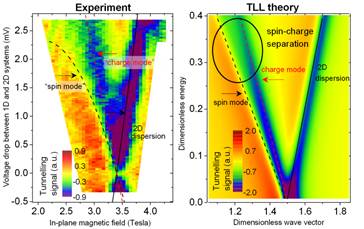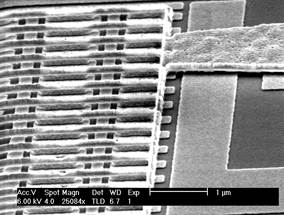Measuring spin-charge separation and high-energy effects in an interacting 1D Luttinger Liquid
The electron is a fundamental building block of nature and is indivisible in isolation, yet we have performed an experiment that shows that electrons in narrow wires can appear to split apart.
Even a very simple conducting system, a wire in which electrons can only move along the wire, so that it is 1D, is not a Fermi liquid, because the electrons repel each other and cannot ‘overtake’. To calculate this is impossible without making one approximation. This model system is called a Tomonaga-Luttinger liquid (TLL). The calculation makes a very surprising prediction: that there are two ways in which a wave can be excited at a given energy. One wave corresponds to the charge of the electron moving along the wire. The other is related to the electron's spin. Spin and charge waves are expected to travel at different speeds.
How can this prediction be tested? If a 1D wire is placed very close to a 2D electron system, electrons can tunnel from one to the other. Energy and momentum must be conserved, so the current that flows between the two depends on the energies and speeds of the waves in the two systems. Applying a magnetic field gives electrons extra momentum as they tunnel, and a voltage between the two systems gives them extra energy. Thus one system can be used to map out the excitations of the other. Our experiment (see figure) showed separate lines corresponding to spin and charge excitations, matching those predicted by the theory. This research is published in Science 325, 597 (2009), Nature Communications 7, 12784 (2016), Phys. Rev. B 93, 075147 (2016), Nature Communications 10, 2821 (2019), Science Advances 8, eabm2781 (2022), Phys. Rev. B 107, 115128 (2023). Some of the work is described here in more detail.

Since this initial discovery, we have made much more complicated devices, such as the one shown in the SEM picture here.

 |
Tsyplyatyev O. et al., “Nature of the many-body excitations in a quantum wire: Theory and experiment”, Phys. Rev. B, 93, 075147 (2016). Tsyplyatyev O. et al., “Hierarchy of Modes in an Interacting One-Dimensional System”, Phys. Rev. Lett., 114, 196401 (2015). |

A printable (PDF) description of this project is available here (128kB).
For more information, please contact Prof Chris Ford.
